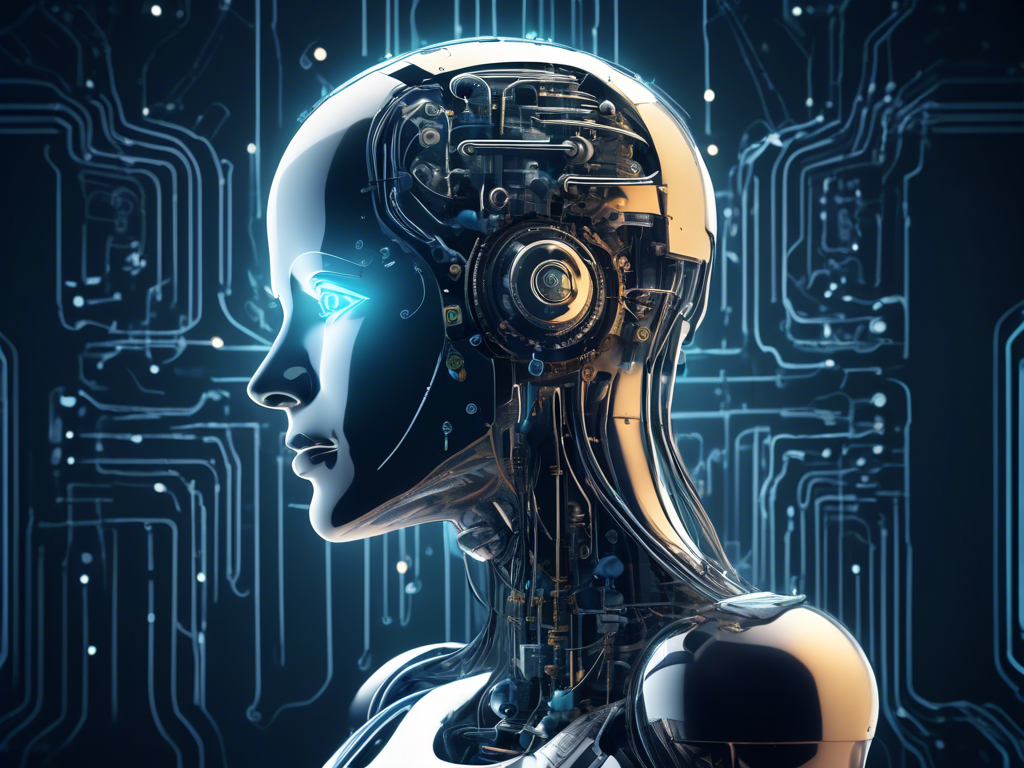In a world teeming with digital transformations, the advent of Artificial Intelligence (AI) has ushered in an era of unparalleled innovation. At the heart of this technological renaissance lies the potential to develop smart systems that not only automate tasks but also evolve with each interaction. This article delves into the intricacies of harnessing the power of Machine Learning for intelligent system design, offering a comprehensive guide to navigating the complex terrain of AI integration within smart technologies.
The escalating demand for efficiency has propelled the evolution of AI-driven solutions for complex systems, carving a path toward the future of automation. But how do these intelligent constructs come to life from mere theoretical concepts? In this exploration, we transition from theory to application, showcasing real-world examples where AI systems demonstrate their prowess. Moreover, we’ll investigate how leveraging artificial intelligence can significantly boost system performance and efficiency.
The journey from imagination to implementation is fraught with challenges, yet the promise of AI is too potent to ignore. With a focus on pragmatic insights, this article serves as a compass for innovators and technocrats striving to embed AI into the fabric of tomorrow’s smart technologies. The ensuing discussion promises to arm readers with the knowledge to conceptualize and deploy AI systems that are not just smart but sentient in their adaptability and learning capacity.
Developing Smart Systems with AI

Harnessing the Power of Machine Learning for Intelligent System Design
In the realm of artificial intelligence (AI), machine learning (ML) stands out as a transformative technology that is reshaping how intelligent systems are conceived, designed, and implemented. By harnessing the power of ML, developers and engineers are not just automating mundane tasks but are also imbuing systems with the ability to learn from data, improve over time, and make decisions with minimal human intervention. This self-improvement capability is central to developing smart systems that can adapt to changing environments and user needs.
ML-driven AI systems leverage vast amounts of data to learn patterns, understand complex scenarios, and provide insights that would be impossible or too time-consuming for humans to derive on their own. This process involves training algorithms on data sets to recognize patterns and predict outcomes, thereby enabling these systems to tackle real-world problems with unprecedented precision and efficiency. The integration of ML into system design is not just about enhancing capabilities but also about making AI systems more robust, scalable, and aligned with human values and ethics.
Key Challenges and Solutions in ML-Driven System Design
One of the key challenges in leveraging machine learning for intelligent system design is ensuring the quality and integrity of the data used for training algorithms. Biased or poor-quality data can lead to inaccurate predictions and decisions, undermining the effectiveness and trustworthiness of AI systems. To address this issue, it is crucial to implement rigorous data cleaning, preprocessing, and augmentation techniques to ensure that the data reflects real-world diversity and complexity.
Another significant challenge is the explainability of ML models. Given the often opaque nature of complex algorithms, making their decision-making processes transparent and understandable to humans is essential, especially in critical applications like healthcare, finance, and autonomous vehicles. Developing explainable AI (XAI) models and incorporating interpretability features from the onset of design can help demystify AI decisions, increase trust among users, and facilitate regulatory compliance.
Overcoming these challenges is not trivial, but with continuous advancements in ML research and practices, developers are increasingly equipped with sophisticated tools and methodologies to design intelligent systems that are not only powerful but also responsible and user-centric. Through iterative testing, ethical AI practices, and a focus on human-AI collaboration, the future of smart system design looks promising, destined to revolutionize industries and enhance our daily lives.
By focusing on these pivotal aspects, the journey toward developing smart systems with AI becomes a collaborative effort between technology and humanity, ensuring that the systems we rely on are not only intelligent but also equitable and sustainable.
Navigating the Challenges of AI Integration in Smart Technologies
Understanding the Complexity of AI and IoT Convergence
As we delve deeper into integrating Artificial Intelligence (AI) into smart technologies, one of the predominant hurdles encountered is the intricate dance between AI and the Internet of Things (IoT). This convergence aims to create a seamless ecosystem where devices not only collect data but also analyze and act upon it intelligently. However, merging AI with IoT introduces complexities regarding data management, privacy, and interoperability. The sheer volume of data generated by IoT devices necessitates robust AI algorithms capable of sifting through information efficiently and effectively, presenting a significant challenge in terms of processing power and algorithm sophistication.
Moreover, ensuring the privacy and security of user data within these systems is paramount. As devices become smarter and more interconnected, the potential for data breaches or misuse increases. Addressing these concerns requires a dual approach: developing advanced encryption methods and fostering a culture of data privacy that prioritizes user consent and transparency.
Scalability and Adaptability of AI-Driven Smart Systems
Another critical challenge in the realm of AI integration within smart technologies is ensuring that these systems are both scalable and adaptable. As the application domains of smart technologies expand, AI systems must be able to scale accordingly, handling an increase in workload without compromising performance or accuracy. This scalability is not just a technical necessity but also a business imperative, enabling organizations to grow and adapt to market changes smoothly.
Adaptability plays a crucial role in the longevity and relevance of smart systems. In a world where technology and user needs evolve rapidly, AI-driven systems must be designed with flexibility in mind, allowing for updates, upgrades, and alterations without significant overhauls. Achieving this level of adaptability requires a forward-thinking design philosophy that anticipates future trends and challenges, embedding agility directly into the architecture of smart systems.
Navigating the challenges of AI integration in smart technologies is no small feat. It demands a concerted effort from developers, engineers, and stakeholders to address issues related to complexity, privacy, scalability, and adaptability. Through innovative design strategies, ethical considerations, and a commitment to continuous improvement, the path forward involves creating intelligent systems that not only enhance our lives but do so in a way that is secure, efficient, and adaptable to the ever-changing landscape of technology and human needs.
The Future of Automation: AI-Driven Solutions for Complex Systems

Enhancing System Intelligence through Advanced AI Algorithms
The cornerstone of the future in automation lies in AI-driven solutions, designed to tackle the complexity of modern systems with unprecedented efficiency. Advances in artificial intelligence are enabling the creation of systems that can not only process and analyze vast quantities of data at speeds far beyond human capability but also learn and adapt over time. This evolution toward more intelligent systems is founded on sophisticated AI algorithms capable of deep learning, natural language processing, and predictive analytics.
These sophisticated algorithms are the key to unlocking higher levels of automation in industries such as manufacturing, healthcare, and transportation. For instance, in manufacturing, AI can predict equipment failures before they occur, minimizing downtime and maintenance costs. Healthcare benefits from AI’s ability to analyze patient data and provide personalized treatment recommendations, improving outcomes. In transportation, AI algorithms optimize routes in real-time, enhancing efficiency and reducing costs. This leap in system intelligence signals a shift towards more autonomous, reliable, and efficient operations across various sectors.
Overcoming Obstacles in Implementing AI Solutions for Complex Systems
Implementing AI-driven solutions for complex systems is not without its challenges. These include data privacy concerns, the need for vast computational resources, and the difficulty of integrating AI technologies into existing infrastructures. Data privacy emerges as a significant concern, especially in sectors like healthcare, where sensitive patient information is involved. Ensuring the security and privacy of this data while leveraging AI for analysis and insights is paramount.
The computational demand of running advanced AI algorithms necessitates substantial investments in IT infrastructure, which can be a barrier for many organizations. Moreover, integrating these AI solutions into existing systems often requires a redesign of workflows and processes, posing additional challenges. However, the potential benefits of AI-driven automation—increased efficiency, reduced costs, and improved decision-making—make overcoming these obstacles worthwhile. By adopting a strategic approach to implementation, focusing on scalability, and ensuring robust data protection measures, organizations can harness the full power of AI to transform complex systems into smart, efficient, and responsive entities.
Facing these challenges head-on, the future of automation through AI-driven solutions looks bright, promising to redefine how we interact with technology and manage complex systems in an increasingly digital world.
From Theory to Application: Real-World Examples of Smart AI Systems
Improving Urban Life through Smart City Technologies
One of the most tangible real-world applications of smart AI systems is found within the development of smart cities. These urban areas leverage AI and the Internet of Things (IoT) to enhance the quality of life for residents by optimizing city services and infrastructure. From traffic management to waste disposal, smart cities utilize data collected from various sources, including sensors and cameras, to make informed decisions that lead to more efficient urban living. For example, AI algorithms can predict traffic congestion and suggest alternative routes in real time, significantly reducing commute times and lowering pollution levels. Similarly, smart waste management systems use AI to optimize collection routes and schedules, leading to cleaner streets and reduced operational costs. These practical implementations of AI not only demonstrate its potential to improve everyday life but also highlight the technology’s adaptability to diverse urban challenges.
Transforming Healthcare with AI-Based Diagnostics and Treatment
Another sector experiencing revolutionary changes thanks to smart AI systems is healthcare. AI-driven diagnostics and personalized treatment plans are becoming increasingly common, providing faster, more accurate diagnoses and tailored treatments. Machine learning models trained on vast datasets of medical records and images can identify patterns and anomalies that may elude human experts, enabling early detection of conditions such as cancer and heart disease. Moreover, AI systems are being developed to predict patient outcomes, assist in surgical procedures, and manage patient care, thereby enhancing the efficiency and effectiveness of healthcare services. For instance, AI-powered virtual assistants provide continuous monitoring and support for chronic disease patients, offering reminders for medication and appointments, tracking health progress, and even providing emotional support. This intersection of AI and healthcare not only exemplifies the technology’s potential to save lives but also underscores its capacity to augment the human elements of care and compassion in medical practices.
By examining these examples, it’s clear that the transition from theory to application in the development of smart AI systems has not only begun but is already making significant impacts across various aspects of society. Whether improving the livability of our cities or the wellness and longevity of our populations, AI demonstrates a remarkable capacity to address complex, real-world problems with innovation and intelligence.
Leveraging Artificial Intelligence for Enhanced System Performance and Efficiency

Optimizing Operations Through Predictive Analytics
Predictive analytics, powered by artificial intelligence (AI), is revolutionizing the way businesses approach system performance and efficiency. By analyzing historical data and identifying trends, AI algorithms can predict future outcomes with remarkable accuracy. This ability allows organizations to anticipate problems before they occur, streamline operations, and allocate resources more effectively. For example, in manufacturing, predictive maintenance powered by AI can forecast equipment failures, reducing downtime and saving costs. Similarly, in the retail sector, AI can analyze consumer behavior to predict buying trends, enabling companies to optimize inventory levels and enhance customer satisfaction. The implementation of predictive analytics signifies a shift towards proactive rather than reactive management, dramatically improving operational efficiency and performance.
Enhancing Energy Efficiency with AI-Driven Smart Grids
The application of AI in energy management, particularly through smart grids, exemplifies its potential to significantly increase efficiency while promoting sustainability. Smart grids utilize AI technologies to analyze consumption patterns, integrate renewable energy sources effectively, and improve the distribution of electricity. By predicting peak load times and adjusting the supply accordingly, these AI-enabled systems can reduce waste, lower costs, and decrease carbon emissions. Moreover, AI-driven smart grids empower consumers by providing them with real-time information about their energy usage, encouraging energy-saving behaviors. As global energy demand continues to rise, leveraging AI for enhanced energy efficiency represents a critical step towards achieving a sustainable future, demonstrating AI’s role not just in optimizing system performance but also in addressing broader environmental challenges.
Through predictive analytics and smart grid technologies, AI is at the forefront of enhancing system performance and efficiency across various industries. By enabling more informed decision-making, improving resource allocation, and promoting sustainable practices, AI-driven solutions are setting new standards for operational excellence and environmental stewardship.
Summing up
Through the prismatic lens of AI, we have traversed a landscape where data becomes decisions, and algorithms awaken as arbiters of automation. The synthesis of machine learning with intelligent system design presents boundless possibilities for enhancing performance and operational efficiency. As we dissected the multifaceted nature of AI integration, it became evident that despite challenges, the forward march of smart technologies is inexorable.
The real-world examples highlighted in this discourse stand as testaments to AI’s transformative impact, powering systems that think, learn, and adapt. As we stand on the precipice of the future of automation, the insights gathered here serve as building blocks for the next generation of AI-driven solutions. These intelligent systems are not merely tools but collaborators, poised to redefine the complexities of modern ecosystems.
As we conclude, let it be known that the journey of AI is perpetual, with each advancement paving the way for untold discoveries. The broader implications of our findings beckon us to consider not just the technology we create, but the future we shape with it. Let this exploration serve as a catalyst, not just for conversation, but for action—encouraging innovators and makers to leap boldly into the algorithmic alchemy that forges tomorrow’s smart, sentient systems.
